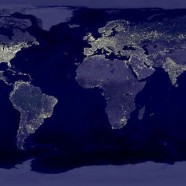LED Lighting In Developing Countries
Worldwide attention was recently centered upon LED technology when the Nobel Prize committee announced that three scientists were awarded the 2014 Nobel Prize in Physics for inventing the blue LED. While many people may have read the news and thought, “maybe it’s time to complete my energy efficient lighting retrofit,” less well-known are the benefits of LED lighting in developing countries.
LEDs, combined with solar panels, have been a called a “transformative technology” for more than a billion people who live without a reliable source of electricity. Today, 5 percent of Africans without access to electricity, around 28.5 million people, are using renewable energy-powered LED lights to break through the dark night. That’s in addition to a growing market in South Asia as well. According to Russell Sturm from a private sector investment arm of the World Bank International Finance Corp, worldwide sales of solar-powered LEDs have been growing at a rate of 150% annually for several years. In the past six months alone, 2.1 million LED-solar products have been sold to people around the world who are unconnected to an electrical grid.
The majority of the 1.3 billion people who are living without electricity rely on kerosene, wood and candles to produce light and home energy. The economic and environmental costs of these light-generating methods have been pointed to as major stumbling block to productivity and economic growth for the world’s poorest people. Kerosene in particular has been called out due to the fact that it’s relatively expensive and increases risk for fire and health damage.
People around the world without electricity spend around $38 billion a year on kerosene. Recognizing the opportunity to disrupt the market, social entrepreneurs have taken to LED technology and are selling it to the world’s poorest people, allowing them to leapfrog the developed world by going straight to renewable sources for their electricity.
Just eight to 10 years ago, the costs of LEDs were still prohibitively costly for the world’s poorest citizens when companies first started marketing solar home lighting systems in the developing world. However, since Isamu Akasaki, Hiroshi Amano and Shuki Nakahmura invented the world’s first blue light emitting diode in the early 1990s, the efficiency of LED technology has been improving by 100 percent per year while costs have been dropping by 50 percent per year. LEDs have made it so that useful light can be produced without requiring any substantial amount of energy.
This technological progress has allowed solar-powered LEDs to be marketed as a low-cost consumer product. Today, solar-powered LED lighting devices range from $10 and up. This means that the world’s poor have access to clean energy technology at a price that’s affordable. Furthermore, the companies involved in producing and selling these lights are able to make them at costs where they can turn a profit.
Solar energy, however, is not alone in the search for a clean, efficient way to power LEDs. GravityLight is an LED light that is powered by a 22-pound bag of sand that steadily turns a gear-train connected to a D.C. motor. Lifting the bag once is good for 30 minutes of light.
The impact of renewable-powered LEDs also carries environmental benefits by reducing contributions of carbon dioxide, a toxic greenhouse gas, into the atmosphere. Every 100,000 solar LEDs sold equates to 10,000 fewer tons of carbon emissions each year.
The development benefits of LEDs are just one of many reasons to be excited about the future of LED lighting. We can’t tell you how happy we are to be a part of it. If you have any questions about LEDs, and specifically LED strip lighting, remotes, and dimmers, please stop by our website at flexfireleds.com or give us a call at 1-844-FLEXFIRE to talk with one of our design specialists today.












